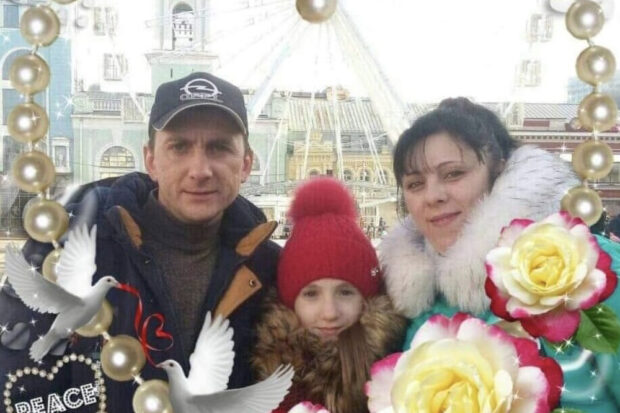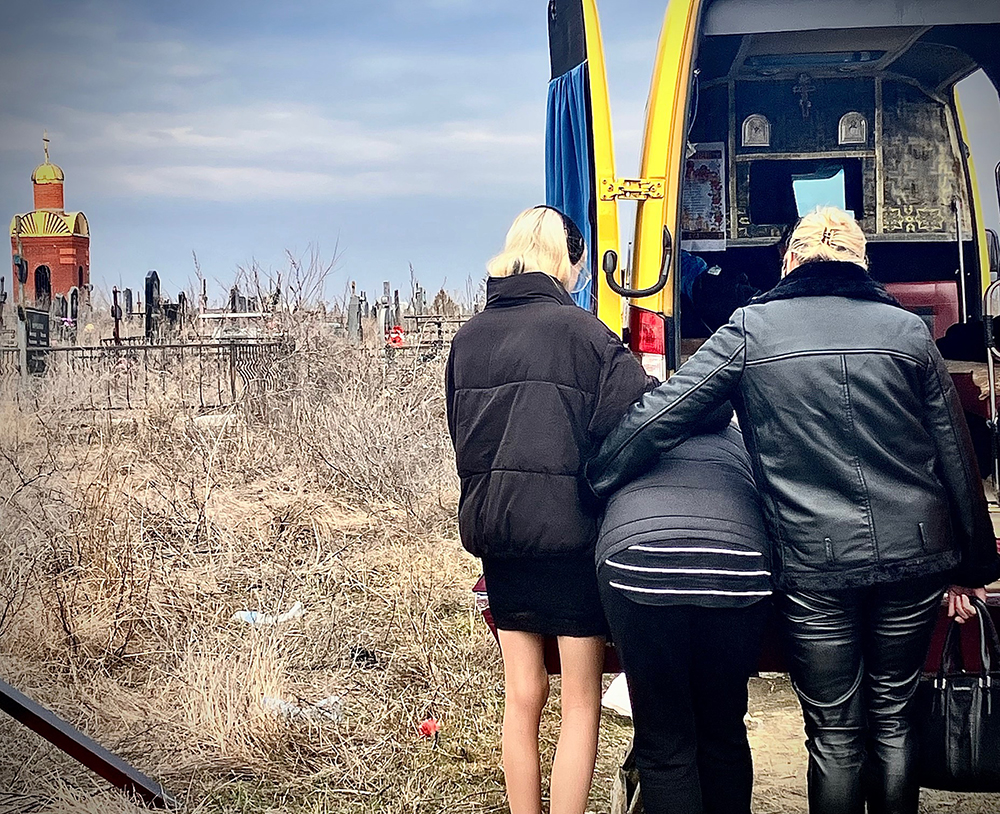
On Feb. 5, Russian artillery hit a southern regional center, Kherson, killing four civilians. With 70,000 Russian troops concentrated in Kherson and Zaporizhzhya oblasts along the Dnipro River, the city, despite nine months of occupation, a major flood and daily shelling for a year and a half, remains resilient. It’s been two years since the Russian full-scale invasion of Ukraine.
At 9:30 a.m. on Feb. 5, in Kherson, Victor, 45, drank boiling coffee in the spacious kitchen, and, scratching his white cat behind the ear, told his wife of 25 years, Svitlana, that their block might get a new power switch and, finally, power, in the early afternoon. He got up and grabbed the car keys.
“Don’t go,” said Svitlana.
Svitlana worried. A Russian shell killed her mother. Just a week earlier, the couple buried a close friend, killed by shrapnel. Two days earlier, the Russians dropped yet another aerial bomb downtown.
Every week, fires took the lives of Svitlana’s friends and acquaintances. After several attacks left little of their own house, the couple moved to a relative’s place, a few blocks down the slope from the Dnipro River. It was the deadliest part of Kherson.

On the other side, a mile away, the Russians targeted their artillery, mortar and tanks at Kherson. Svitlana and Victor sent their children, 16 and 24, to the nearby city of Mykolaiv.
Yet, no matter how hard Svitlana insisted, Victor would not cancel the work assignment by the river port, a major target area for Russians. A welder and an experienced construction worker, he would not budge. Kherson, pummeled by the Russians around the clock, needed its communal services workers to deliver. And anywhere in Kherson was dangerous.
Victor left the house, met his colleague—and a childhood friend—and they drove to the river port neighborhood. The day was foggy so the Russian reconnaissance drones had a harder time hunting cars and dropping explosives on them.
Svitlana stayed next to the city library, destroyed by a Russian aerial bomb. The head of a community association, loved by her neighbors for her ability to solve problems, fearlessness and optimism, Svitlana was in charge of power, water, Internet and overall logistics, a demanding task in the city under daily fire for the last year and a half.
Many houses, just like Svitlana’s, were damaged or destroyed; most had no electricity or running water for months. Collapsed roof beams and strange rib-like structures stuck out as if some giant predators feasted on Kherson.
Just like any other morning, Svitlana worked on distributing humanitarian aid and generators to the nearby houses, coordinating with other volunteers and the city authorities, and paying little attention to the habitual rumble of the artillery fire. A few hours flew by fast.
At 12.04 p.m., her phone rang. Olha, a close friend and a neighbor, called. Victor’s car was hit by a piece of shrapnel, and caught on fire, she said. The ambulance was on the way. The shelling continued.
Olha, the owner of a grocery store located by the river port, knew what it meant to get such news. Last summer, her fiancé and a lifelong friend were blown to pieces by a Russian mine.
In a few minutes, Svitlana got an update: Victor and his friend burned to ashes. By 2 p.m., four civilians were killed, and one injured. All four were Olha’s friends and customers. Liudmila, in her late 60s, was one of the elderly Olha helped with the bills, Internet and driving.
That night, Svitlana had a dream: Victor sat in the kitchen, drinking coffee and playing with the white cat. He told her not to cry. That’s when she started to scream. She spent the next day in the morgue and administration offices, obtaining the death certificate and paperwork needed for the funeral.
Her friends and neighbors helped, and by midday, as the Russians started to shell the city again, she was back home, sitting in the dusk, two cats rubbing against her ankles, a charred, thin ring weightless on her palm. All that was left of Victor was a deformed black wedding ring.
Her son, daughter and father sat on a couch across the room from Svitlana, in silence. They just drove back from Mykolaiv. Everything around was built or fixed by Victor. A skillful handyman, he made the large room look cozy and made it their own. Trinkets and framed photos glistened on shelves.
Little light came through the windows, Scotch tape covering the glass in crisscross patterns to protect it from shock waves. A radio blasted the news of the Russian missiles hitting Kharkiv, a city in eastern Ukraine. An air raid siren kept wailing, and dogs howled. Across the street, Olha worked with the maintenance crew on installing the power switch.
Svitlana held a tall glass with a warm Mojito lemonade with a splash of vodka, without drinking it. She took off a black silk scarf because it was squeezing her head, hurting her, and placed it on the desk, next to the death certificate, and a glossy 1990s Kodak photo of Victor.
Married at 20, she and Victor looked alike: many took them for siblings. “He had such dark blue eyes,” she said. “Gray, but if he swam for a long time in the river, they turned so transparent turquoise-blue.”
His daughter, a tall, skinny teenager in oversized glasses, looked at a recent selfie: she and Dad, smiling. In the morgue, the doctor advised against looking at the remains. “It will haunt you to the end of your days,” he said.

Marriage is never easy, and family life in times of war is not a walk in the park. They had fights, but in October they were going to celebrate their 25th anniversary. And the following week, Feb. 14, they were going to go to Mykolaiv for a party for their son’s 24th birthday and Valentine’s Day. Svitlana would be dancing and singing her favorite song, “This is my country, this is my land. My family is here. Ukraine…”
A loud explosion roars over the river and echoes through Kherson.
The once thriving southern city with a prewar population of 260,000 stood still. After two years of invasion, Kherson is almost a ghost town, with packs of shaggy dogs roaming the empty parks, torn posters flapping in the wind and faded rags hanging off broken branches.
Once sparkling fountains have dried up; lakes and pools have emptied and tall grass grows through the cracks between the tiles of the pathways. Here and there, mangled pieces of rusty metal wobble like tumbleweeds on the road: fragments of Russian shells and missiles.
Small nail-like darts darken the broken asphalt: the deadly cluster munition parts. No children play at the eerie playgrounds—most were evacuated a long time ago.
With most businesses closed, there are no jobs in Kherson. The financial aid paid by the government is hardly enough to cover food and is not enough to cover the monthly heating, electricity, water and gas bills—even though the riverside districts live without any amenities.
In the 1990s and 2000s, Kherson, like many regions in Ukraine, went through a tough period of mafia rule. Even before the full-scale invasion, the political landscape was complex.
In February 2022, Kherson became the first regional center occupied by the Russian troops. During the occupation, quite a few in the city chose collaboration. They fled with the invaders to the other bank in November 2022 after the liberation. A few empty villas on Svitlana’s street used to belong to the collaborators.
On Feb. 8, 2024, about 30 neighbors gathered in the family’s backyard for Victor’s memorial. About 30 women and men crowded in silence, cradling dancing flames of thin, yellow wax candles with their palms. The casket was closed—and empty. Phones were in airplane mode: Russians looked for the signals conglomerating in one place and targeted such gatherings.

Svitlana sat on a chair, in black, her silk scarf back on, sometimes rocking back and forth and moaning quietly. Her daughter, in a black veil over her blonde hair, stood by her side, and the son ran back and forth, helping to carry wreaths and distributing traditional favors, simple candies and cookies in plastic bags. Her father sat next to her, eyes blank, remembering his wife’s funeral just a few months ago.
The priest said, “With missiles and drones flying today, you could have stayed home. No one would judge you if you didn’t come. Thank you for being here and praying. Sometimes, I come to a funeral, and there is no one.”
After every sentence came a rumble of explosion. One roared close. People rushed into the garden, squeezing into walls.
“Hide,” said one lady. “Remember Hroza?”
In Hroza village, in Kharkiv Oblast, a Russian high-precision missile Iskander killed roughly half of the residents—52 men, women and children attending a funeral service in the fall of 2023.
Olha stood in the back, ready to help, examining the sky for drones. She thought of her fiancé and of her friend Liudmila, also killed on Feb. 5. Olha always said that this was not the time to be emotional. They all would have time to process their grief after the war. Right now, there are too many elderly to assist and amenities to restore.
At the cemetery, a van with the casket drove by dozens of new marble monuments without names on them, by fresh graves of the military, yellow-and-blue flags flapping in the wind. Svitlana kneeled in front of the coffin. Explosions echoed over the graves.

